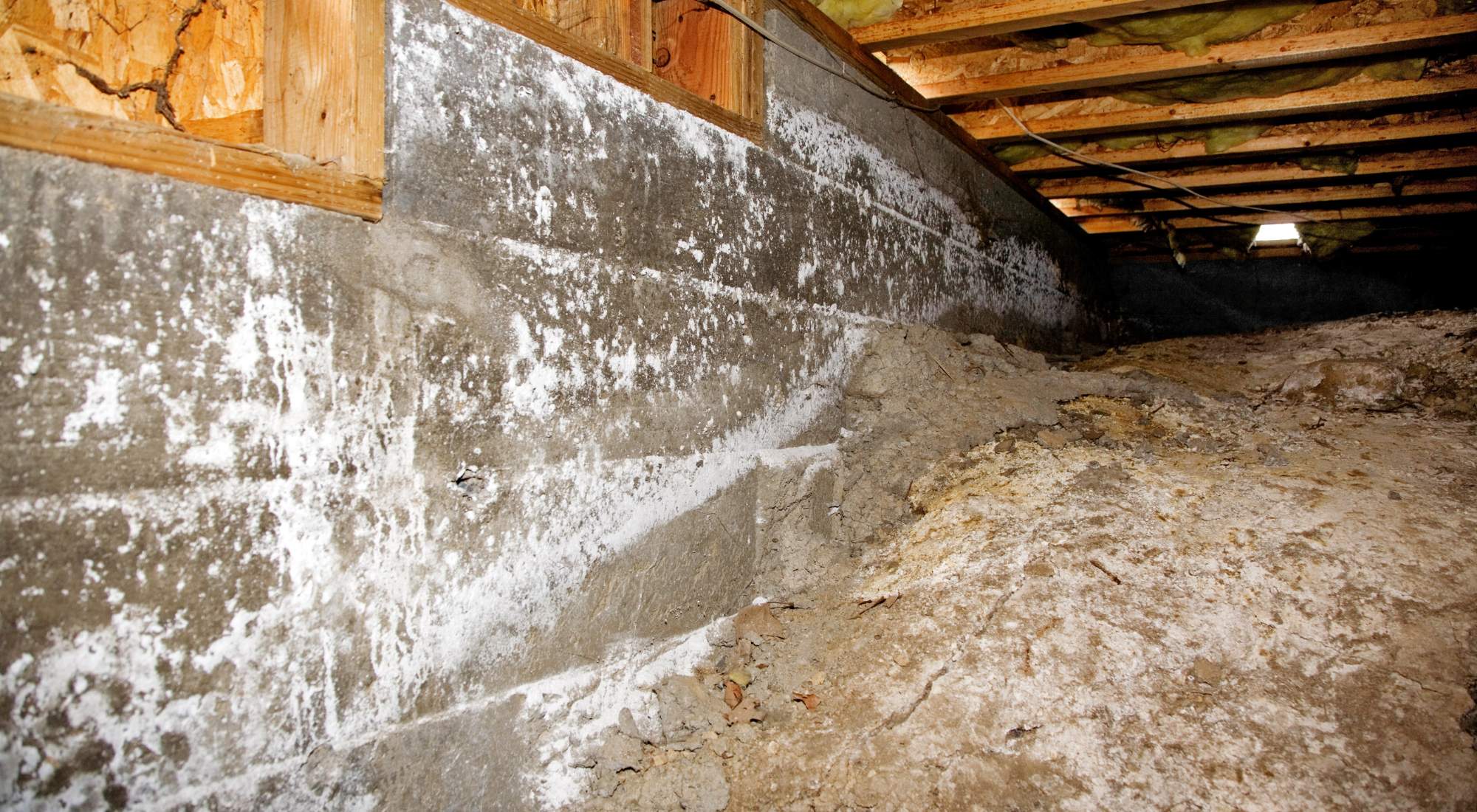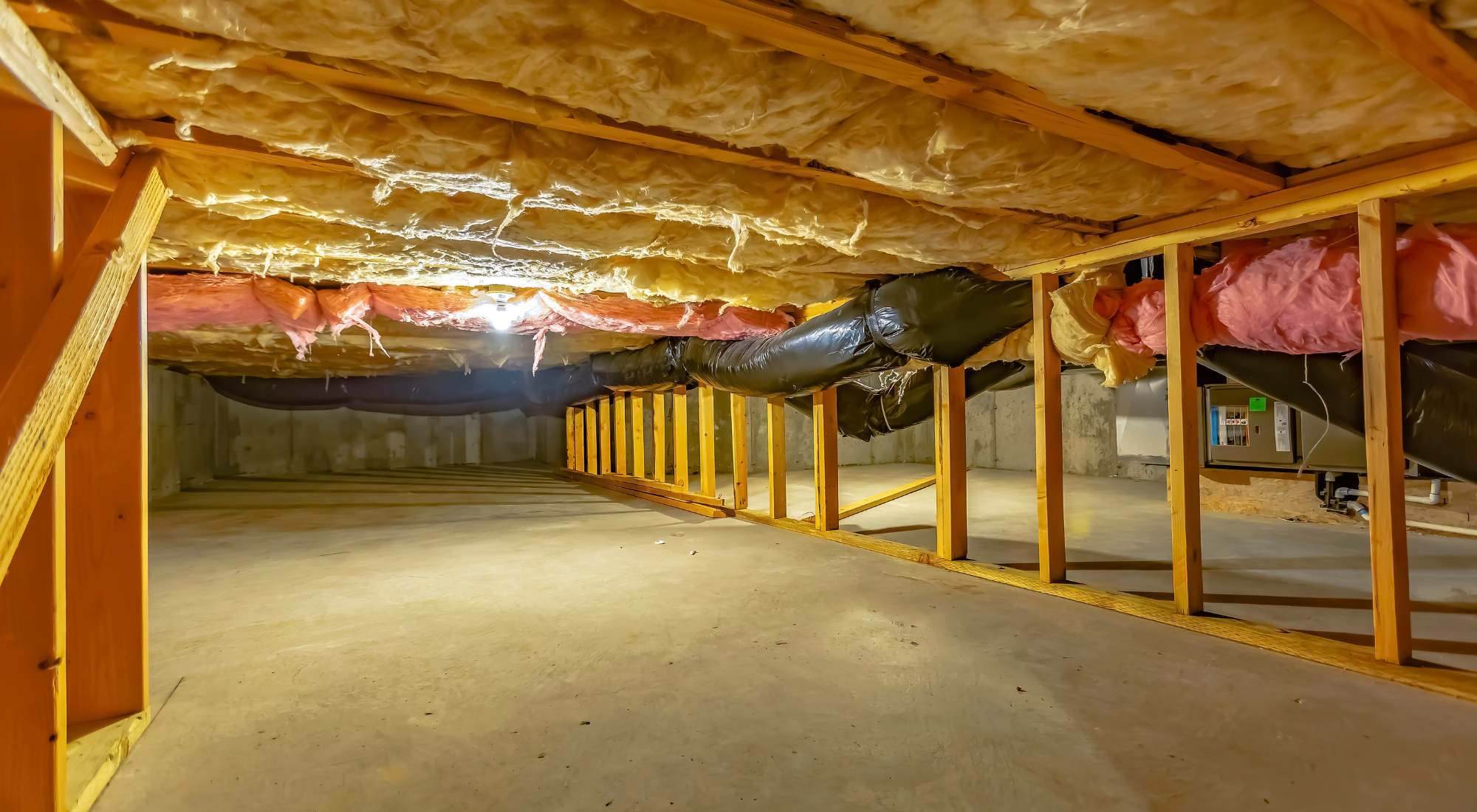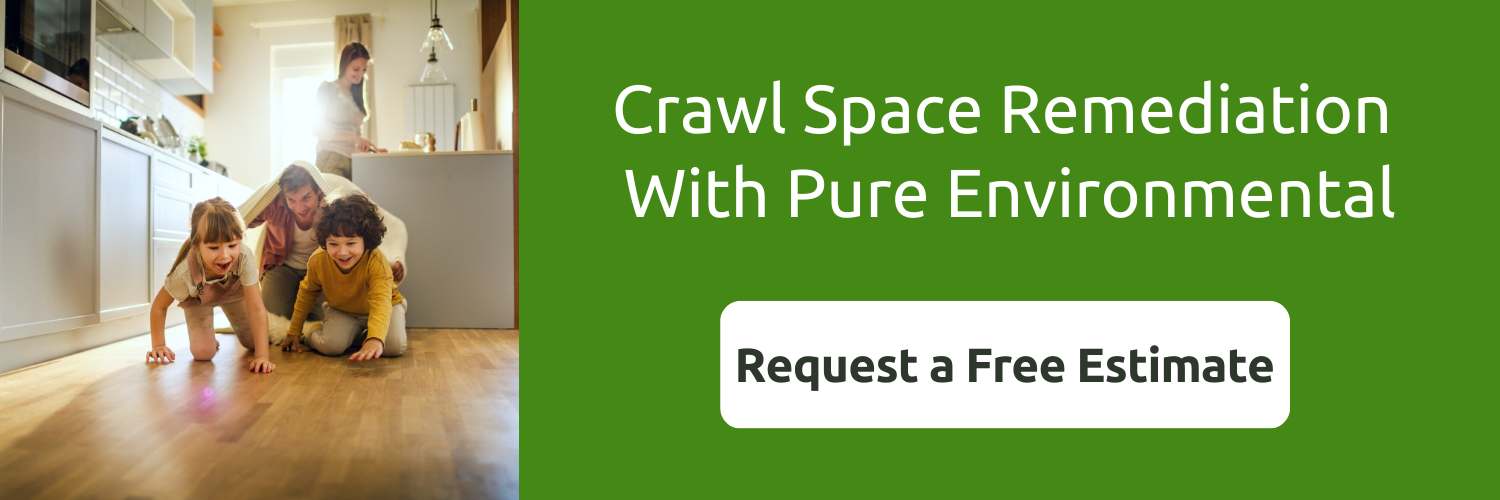The idea of cleaning crawl spaces may give you the heebie-jeebies. Crawl spaces tend to be where unwanted things lurk, like:
- Spiders
- Mold and mildew
- Old construction materials
- Rodents and other wildlife
- And maybe even those boxes you never opened after your move.
It’s nerve-wracking — and potentially dangerous.
However, cleaning and maintaining your crawl space is not just good for your peace of mind, it’s good for the overall wellness of your home. Follow our tips on how to clean a crawl space and why it should be done.
Table of Contents
- How Do You Clean Dirty Crawl Spaces?
- The “How” for Cleaning Crawl Spaces Depends on the “Why”
- Why Begin a Crawl Space Clean-Up: 5 Common Issues
- How Do You Maintain a Crawl Space?
- The Most Important Thing To Remember for DIY Crawl Space Cleaners: Protect Yourself
- What To Do if There Are Harmful Contaminants in Your Crawl Space
- Pure Environmental: Your Professionals for Cleaning Crawl Spaces the Right Way

How Do You Clean Dirty Crawl Spaces?
Crawl spaces are meant to be a little dirty as they’re considered outdoor spaces. But if you’re cleaning your crawl space due to evidence of rodents, mold, or another problem, “how” to clean a crawl space depends on the “why.”
Different issues require different cleaning techniques and preparation.
The “How” for Cleaning Crawl Spaces Depends on the “Why”
Start with a targeted goal as to why you’re cleaning your crawl space. You may prefer it to remain tidy and dust-free, or you may have recently noticed a damp or musty odor.
Knowing the why will help you with the how. For example, removing black mold will require the help of a professional, whereas cleaning up debris, such as leaves and sticks, requires a little dirty work on your part.
Or perhaps you’ve noticed animal droppings, in which case you want to ensure the animals are removed from the space before removing their nest and droppings.
Maybe you’ve just got a bunch of unpacked boxes or construction materials taking up the space and creating a potentially cozy spot for animals to hide. In this case, you should remove all boxes and materials and dispose of them accordingly.
Below, we list specific examples of what might be cluttering or dirtying up your crawl space and the cleaning technique for each.
Why Begin a Crawl Space Clean-Up: 5 Common Issues
#1: Leftover Construction Material
Old wood, cardboard, or other materials can start to rot, eventually causing mildew and mold. This is potentially hazardous for a couple of reasons:
- Your ventilation system is usually tucked under your crawl space. Mold can travel through the vents and contaminate the air you’re breathing.
- Mold can spread to the structural supports of your home and eventually cause rot which can lead to expensive repairs.
Another reason you want to remove old boxes or construction debris is that it creates an inviting home for rodents or raccoons.
Rodents and raccoons can wreak havoc on your home. Not only do they leave behind their droppings, but they can chew through wires, wood, and more.
Cleaning old boxes and construction debris usually requires nothing more than some hard work on your part.
However, you should always inspect the area first to ensure you don’t have a mold or rodent problem. If so, it’s time to call the professionals.
#2: Visible Wear and Tear or Damage
If your crawl space clean-up mission is a result of damage, such as a flood, or general wear and tear, then you may want to call in a professional.
During flooding or other disasters, mud can build up and block or damage vapor barriers. Vapor barriers are important because they block ground moisture and help prevent mold and fungus from growing.
Vapor barriers also prevent the growth of certain bacteria in the soil and reduce odors from the soil being released into the home.
Disaster damage should always be handled by a professional. Structural damage may occur during a flood, tornado, or hurricane and create a potentially hazardous environment.
Hire a professional, like Pure Environmental in Tacoma, WA, to inspect your crawl space for damage before you enter the space. In addition to your vapor barriers, insulation and other materials should be inspected as well.
Once the crawl space is deemed safe for entry, you can begin the clean-up yourself — if the damage is minimal — or have the professionals finish the job.
#3: Evidence of Mold
If you’ve started to notice that your whole house is smelling musty, you may have mold in your crawl space. If you discover mold in your crawl space, it should be cleaned as soon as possible.
According to the CDC:
“Exposure to molds can lead to symptoms such as stuffy nose, wheezing, and red or itchy eyes, or skin. Some people, such as those with allergies to molds or with asthma, may have more intense reactions.”
Mold remediation is possible as a DIY, but it’s critical to have the proper PPE (personal protection equipment), cleaning products, and a whole lot of patience.
You can follow these steps on how to clean a crawl space with mold:
- Inspect the area: Wear your PPE, set up lights, and set up plastic sheets to contain mold spores released into the air as it’s cleaned.
- Spray with mold removal product: Allow the foam to expand and loosen the mold before you begin cleaning the surfaces.
- Soak the area with a mold killer: Using a homemade or commercial mold-killing mixture, soak the area where the mold was to kill any remaining spores and remove the stains.
- Scrub off the residue: Once the area is dry, use a stiff-bristled brush and scrub off any remaining mold. This takes a long time as you need to be very thorough.
- Properly dispose of all materials: Carefully remove and fold plastic sheeting and seal it in a trash bag. Dispose of all contaminated gear, including coveralls and brushes, and store all bagged items outside of the home for trash pick-up.
- Prevent future mold issues: Creating a climate-controlled environment will best help prevent mold from reoccurring. Install a dehumidifier and schedule inspections every spring and fall.
While it may be tempting to do it yourself and save a little money, mold removal is a tedious and potentially hazardous job. If you ask us, mold is one of those situations that’s best left to the professionals.
#4: Excessive Dust and Debris
It’s perfectly normal for dust and debris to build up in your crawl space. However, if someone in the home has a severe allergy or sensitivity, regular crawl space clean-ups are recommended to avoid an excess of dust and debris.
You may find leaves, branches, or other outdoor debris that has flown in on a windy day. And dust tends to gather in every part of your home, the crawl space is no exception.
The problem with excessive dust and debris is that it can create an attractive space for rodents and other pests to make a nest.
Using a shop vac, vacuum the area every spring and fall to avoid messy build-up. Or schedule regular crawl space maintenance with a professional and avoid getting down there altogether.
#5: Evidence of Rodents
If you have rodents, such as rats or mice, or other creatures, such as raccoons, living in your crawl space, it can become a major issue.
Not only do these pests leave a mess of urine and feces behind, but they can damage your insulation and wiring as well.
Rodent feces are known to carry Hantavirus, which can lead to HPS (Hantavirus pulmonary syndrome) in humans.
Cleaning crawl spaces with rodent mess left behind can be a tricky situation.
First, you need to exterminate or eliminate these pests from your home and seal the entry points.
From there, you will need to sanitize the area with an industrial fogger, replace the vapor barrier, and remove and replace contaminated insulation.
Finally, you need to exclude the rodents from the crawlspace by sealing any openings greater than the size of a quarter.
Or…
You can call the professionals at Pure Environmental. Rodent cleanup is no small task, and if not done correctly, can leave behind harmful contaminants that can make you or your family sick.
How Do You Maintain a Crawl Space?
These four steps will help to maintain your crawl space and avoid potential problems:
- Make sure moisture is not getting into your crawl space.
- Block rodents from entering and properly ventilate the space with vapor barriers and vents.
- Insulate your crawl space for climate control.
- Inspect and clean your crawl space twice a year.
When it comes to crawl spaces, prevention is key. Taking the time to ensure your crawl space is properly maintained will help you to avoid costly clean-ups in the future.
The Most Important Thing To Remember for DIY Crawl Space Cleaners: Protect Yourself
If you’re a bonafide DIYer and decide that you want to tackle your crawl space clean-up on your own, protecting yourself is essential.
Your crawl space may contain potentially harmful contaminants, such as rodent feces or mold, so it’s important to protect your skin and respiratory system.
Proper PPE should include:
- Non-porous gloves
- Eye protection
- Mask or respirator
- Rubber boots
- Long-sleeved shirt and pants
If you have excessive mold or animal droppings, you may want to consider a protective suit.
Before getting into your crawl space to begin working, check the age of your home to know whether or not asbestos could be present.
Many crawl spaces in older homes may contain asbestos or asbestos-contaminated soil. If your home was built before 1989, or when most asbestos-containing products were outlawed, it’s best to have a professional inspect the area before you begin your clean-up.

What To Do if There Are Harmful Contaminants in Your Crawl Space
We highly recommend that you call a professional if you have or suspect you have any of the following in your crawl space:
- Dead or live animals
- Rodent feces or urine
- Mold
- Broken or leaky pipes
- Wood rot
- Asbestos
- Electrical damage
A crawl space that hasn’t been maintained or has suffered damage due to a natural disaster may not be safe. A professional has the knowledge, equipment, and experience to repair any damage, clean the area thoroughly, and install any preventative measures.
Don’t risk your safety, it’s not worth it!
Pure Environmental: Your Professionals for Cleaning Crawl Spaces the Right Way
Cleaning your crawl space is a messy and possibly hazardous job. If you don’t want to do it yourself, we don’t blame you one bit.
While you might think doing it yourself will save you money, oftentimes, hiring a professional is not as much as you would expect.
The professionals at Pure Environmental in Tacoma, WA, are experts at crawl space clean-up. We know how to clean a crawl space and how to prepare your crawl space to prevent future issues.
Whether it’s rodents, mold, mud, or dust, we’ll get the job done right so that you can rest easy knowing the underbelly of your home is in tip-top shape.
Call us for more information or to book your crawl space inspection.
Recent posts
- Home Insurance During Renovations: What Is Covered and What To Know Before Getting Started
- Mitigation and Restoration: Understanding the Difference Between the Two and Why They’re Both Necessary
- Should You Stay or Should You Go? Know When To Walk Away From a House With Mold
- How To Get Rid of Weed Smell: Top Tips To Help Cannabis Users and Growers Keep Their Homes Smelling Fresh and Clean
- HVAC System Longevity and Understanding When It’s Time To Replace Yours
